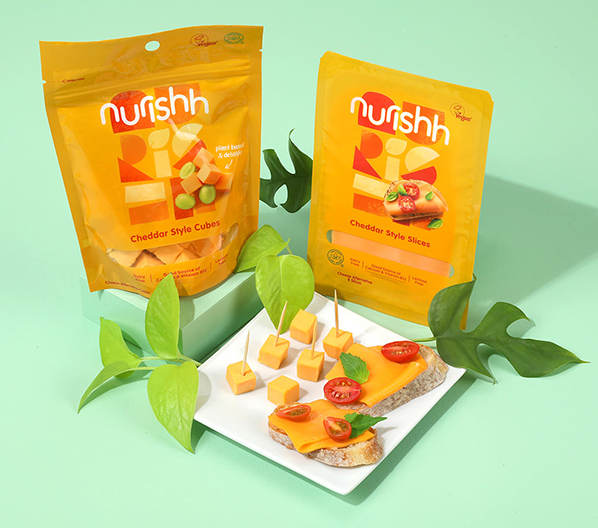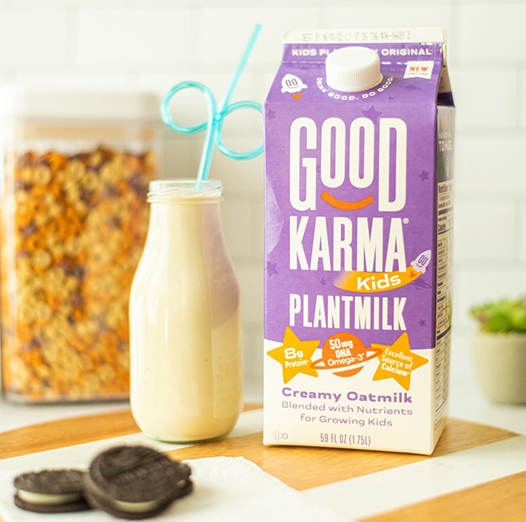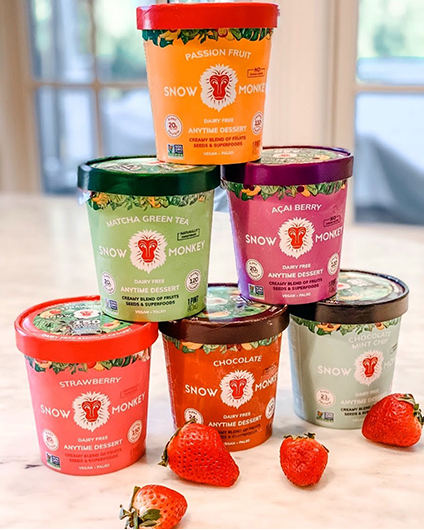Every year, Innova Market Insights releases predictions for the top trends that best capture the mood and direction of the food, beverage, and ingredient industry in the coming year. The revolution in plant-based products has been prominent for the past few years, so it should come as no surprise that several of Innova Market Insights’ Top 10 Trends for 2022 relate to plant-based innovation.
Our number one trend, “Shared Planet,” describes consumers’ collective responsibility for taking care of the environment. The plant-based dairy narrative revolves around hot button environmental issues such as sustainability, lowering of greenhouse gases, carbon footprint, and animal welfare.

New Snack Solution: Bel Brands’ alternative cheese cubes are made with coconut oil, sunflower oil and pea protein. Photo courtesy of: Bel Brands USA Inc.
Innova’s second top trend, “Plant-Based: The Canvas For Innovation,” highlights the creativity in the development of plant-based products (including dairy) that better replicate the functional, sensory, and nutrition properties of their conventional counterparts. Meanwhile, the trend, “Back to the Roots” describes movement by consumers and manufacturers toward products that are traditional, artisanal, and authentic. This trend presents an interesting counterbalance to the sophisticated technology employed in the manufacturing of plant-based dairy products.
Dairy alternatives have global appeal
Dairy alternatives appeal to broad subsets of consumers globally. They are widely embraced in Asia, where plant-based foods play a prominent role in the cuisines of many countries. Interestingly, when it came to the 2021 Innova Meat, Dairy & Alternative Protein Survey, respondents in India tended to prefer plant-based foods over meat and dairy. In contrast, consumers surveyed in countries in Europe and North America—regions with long-established animal meat and dairy consumption—strongly prefer animal products over plant-based alternatives.

Good Karma says Kids Plantmilk delivers 8g of pea protein and 50mg of DHA Omega-3s per serving, while also being an excellent source of calcium and vitamin D. Photo courtesy of: Good Karma Foods Inc.
The Meat, Dairy & Alternative Protein Survey examined motivators of plant-based consumption. While only 5% of consumers in the US say they are vegan, 25% say that they regularly eat plant-based foods as an alternative to meat or dairy. This may be driven by a number of reasons—including religious beliefs and health (e.g., lactose intolerance), as well as ethical/ environmental reasons. Health is the most likely reason given by US consumers for consuming dairy alternatives, although this under-indexes for US consumers compared to the global average. When we asked US consumers specifically about non-dairy cheese, the highest percentage, 31%, named health; 27% cited taste; 18% environmental; and 17% indulgence. Those who reported increasing consumption of non-dairy cheese did so because it is healthy (45%) and environmentally responsible (35%).
Consumers also expect plant-based products to equal the nutrition of their animal counterparts. Globally, at least 40% of consumers say that matching nutrition, including protein, it is “very” or “extremely” important.
It’s interesting to note that consumer understanding of protein is relatively low. While consumers say that complete protein sources are appealing, healthy, natural and sustainable, only one-sixth of those surveyed correctly describe a complete protein as containing all the essential amino acids. In contrast, the highest percentage of consumers incorrectly say that a complete protein source contains plant and animal protein, and nearly 15% of those surveyed report never hearing the term.
An earlier survey, Innova’s 2020 Category Survey, found that consumers in Indonesia (25%) and Thailand (23%) were most concerned with protein claims, and one in eight consumers globally named high in/source of protein among the factors that most influence purchasing decisions when buying dairy alternative drinks.
Protein bases are expanding and evolving

Protein by the Pint. Each pint contains 20g of plant protein from hemp seeds. Photo courtesy of: Snow Monkey Inc.
Dairy alternative beverages, yogurts, cheeses, and ice creams typically do not match the protein content of their traditional counterparts. This can be explained in part by the formulation challenges associated with plant protein ingredients, including their effects on texture and taste. The most popular dairy alternatives on the market today—involving oat, almond, cashew, coconut—tend to be low in protein. Soy, a high protein quality base, is less widely used today than in the early years of plant-based dairy alternatives. Our data suggest that protein content may be increasing in dairy alternatives.
Approximately one-fifth of dairy alternative launches in 2021 carried a protein claim on their packaging, with “high in protein” and “source of protein” claims being most prevalent in North America and Australasia.
Inclusion of protein ingredients varies across subcategories. Dairy alternative drinks are the most popular vehicle for protein claims. In 2020, 14.5% of dairy alternative drink launches had plant protein ingredients, for a global compound annual growth rate of 23% between 2018 and 2020. On the other hand, penetration of protein claims on non-dairy yogurt, ice cream, and frozen yogurt have declined because launches tend to utilize bases that are naturally low in protein.
Innova Market Insights does see movement in the protein content of non-dairy cheeses, a small but growing subcategory. North America shows above-average new product development of non-dairy cheese for the 12 months ending Q3 2021, and US consumers continue to increase their consumption of dairy and dairy alternative cheeses, in part because they perceive cheese as healthy.
Looking at the core protein ingredients used in dairy alternative drinks, milk with pea protein saw the fastest compound annual growth at 72% during a five-year period between 2017 and 2021. Oat and soy were the most active base ingredients in 2021, with a 24% share of activity each, ahead of almond milk with 21% and coconut milk with 12%. All other bases ingredients took shares of less than 6% each.
Although soy protein remains important, manufacturers are turning to pea protein as an alternative for consumers who are looking for soy-free and/or allergen-free products. Pea protein also may be added to boost the protein content of a low protein plant base such as almond.
Pea protein and fava protein are evolving into important protein sources for other types of dairy alternatives. Pea protein is utilized in non-dairy desserts and spoonable non-dairy yogurt. Fava bean protein emerges as a protein ingredient in a small but growing number of non-dairy yogurt and non-dairy cheese launches. New plant protein options also are growing in dairy alternative launches. These include pumpkin seed protein, rice protein, and hemp protein. Growth also is strong among isolates, the more concentrated forms of plant protein.

Spread the Love: Prosperity Organic Foods says Melt Organic Cheesy Spreadable delivers 21g of “healthy plant protein” from chickpea and fermented pea. Photo courtesy of: Prosperity Organic Foods Inc.
Protein claims jumped in 2021 in non-dairy cheeses after little activity in previous years. Use of protein ingredients in plant-based cheese tripled between 2017 and 2021, supported by growth in products with chickpea protein, fava bean protein, and pea protein. Potato protein also is utilized in cheese alternatives but in amounts that are too low to make a meaningful contribution to protein content. As protein content goes up in dairy alternative cheeses, Innova forecasts more opportunity for cheese products to be targeted as the main protein source in a meal.
Brands are diversifying their portfolios to disrupt the market and take a bigger bite out of the plant-based pie. Some reinvent an established favorite with a plant-based twist. One example would be Bel Brands’ Nurishh cheddar cheese cube. Bel also offers a plant-based alternative to its classic Babybel snack cheeses. Elsewhere, the Swiss food giant Nestlé introduced a wide range of dairy alternative products in Europe. These include its pea protein-based Wunda dairy alternative beverage. Wunda has a high nutritional value and a neutral flavor profile that lends itself to many uses.
Technology advances expand ingredient options
Investment and advances in precision fermentation have the potential to broaden the range of protein ingredients that are available to manufacturers of dairy alternatives. A number of start-ups use precision fermentation to cultivate mycoproteins and yeast cultures that can be processed into protein ingredients for the dairy industry.
Precision fermentation also can generate non-animal whey that offers similar performance and nutrition to whey protein. In 2021, ice creams were the main subcategory for launches of non-animal whey. Look for dairy alternatives with precision fermentation ingredients to gain traction in late 2022.
Going forward, sustainability will be a main focus
Sustainability is a hot button issue for consumers and the dairy industry’s “footprint” continues to be a focal point. Innova Market Insights data show more than one-quarter of dairy alternative launches in 2021 carried a sustainability claim, compared to only 5% in 2020.
Bottom line? It’s no longer enough for dairy alternatives to simply be plant-based. Increasingly, new product development is focused on products that replicate the taste, texture and nutritional content of their conventional dairy equivalents—AND with higher ethical standards (less environmental impact.)
Advances in measurement techniques for environmental impact will allow manufacturers to better assess and then promote the sustainability of their ingredients and products. As more natural production technologies such as precision fermentation advance, producers will have access to a wider variety of sustainable protein ingredients. Protein generation from natural source—such as mycelium, fungi and algae—also can appeal to consumers seeking more natural options.
Also expect to hear more about proteins that are upcycled from the waste streams of starch and oil production. The pressure on the dairy industry to become more sustainable will only increase. All companies will be expected to have sustainability commitments in place and to communicate those to consumers.
